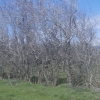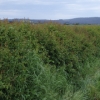
Practiced in England and parts of Europe for over two thousand years, and Tasmania for almost 200 years, hedgelaying is the traditional and best way to maintain hedgerows in a “working” (stock proof) condition and to re-invigorate old and gappy hedges. Hedgelaying is now being used increasingly on farms in Tasmania, to manage hedges and bring them back into working condition.
 Hawthorn hedges were planted extensively throughout early Tasmania (Van Diemans Land), to enclose fields, as was done in England. Hedges were almost unknown before 1810 but from 1820 onwards they were becoming quite common, and by 1840 parts of the colony were said to be more English than England! Once the hedges started to get gappy at the base or tall, leggy and gappy (like the one pictured on the right) they won’t contain stock, which is the reason that they were planted in the first place. So that’s when the hedge layer’s skill is called on.
(Click image to enlarge)
Hawthorn hedges were planted extensively throughout early Tasmania (Van Diemans Land), to enclose fields, as was done in England. Hedges were almost unknown before 1810 but from 1820 onwards they were becoming quite common, and by 1840 parts of the colony were said to be more English than England! Once the hedges started to get gappy at the base or tall, leggy and gappy (like the one pictured on the right) they won’t contain stock, which is the reason that they were planted in the first place. So that’s when the hedge layer’s skill is called on.
(Click image to enlarge)
 Practiced in England and parts of Europe for over two thousand years, hedgelaying is the traditional and best way to maintain hedgerows in a “working” (stock proof) condition and to re-invigorate old and gappy hedges. Used predominantly with hawthorn, it involves putting a cut (pleach) in the back of the trunk with an axe or chainsaw, leaving a pliable hinge of wood at the front. This hinge is trimmed down further with a billhook while the trunk of the tree (known as the pleacher) is laid down into the line of the hedge at an angle of 35-45 degrees. The next pleacher is laid down on top of the previous one, and so on. Stakes are driven into the hedge line through the laid pleachers. Binders, traditionally coppiced hazel, (in Tasmania, dogwood or satinwood is used), are then woven around the top of the stakes to secure the pleachers. The cut stumps are trimmed. The end result is a unique-looking stock proof hedge.
(Click image to enlarge)
Practiced in England and parts of Europe for over two thousand years, hedgelaying is the traditional and best way to maintain hedgerows in a “working” (stock proof) condition and to re-invigorate old and gappy hedges. Used predominantly with hawthorn, it involves putting a cut (pleach) in the back of the trunk with an axe or chainsaw, leaving a pliable hinge of wood at the front. This hinge is trimmed down further with a billhook while the trunk of the tree (known as the pleacher) is laid down into the line of the hedge at an angle of 35-45 degrees. The next pleacher is laid down on top of the previous one, and so on. Stakes are driven into the hedge line through the laid pleachers. Binders, traditionally coppiced hazel, (in Tasmania, dogwood or satinwood is used), are then woven around the top of the stakes to secure the pleachers. The cut stumps are trimmed. The end result is a unique-looking stock proof hedge.
(Click image to enlarge)
 New growth from the pleachers and the stumps will then grow, sometimes as much as 6 feet in the first spring. By the following spring most of the pleachers will be hidden by the vigorous growth. The hedge can then be trimmed by hand or with a tractor mounted trimmer or flail, or can be left to grow tall again. It will remain stock proof for 30-40 years and can then be laid again.
(Click image to enlarge)
New growth from the pleachers and the stumps will then grow, sometimes as much as 6 feet in the first spring. By the following spring most of the pleachers will be hidden by the vigorous growth. The hedge can then be trimmed by hand or with a tractor mounted trimmer or flail, or can be left to grow tall again. It will remain stock proof for 30-40 years and can then be laid again.
(Click image to enlarge)